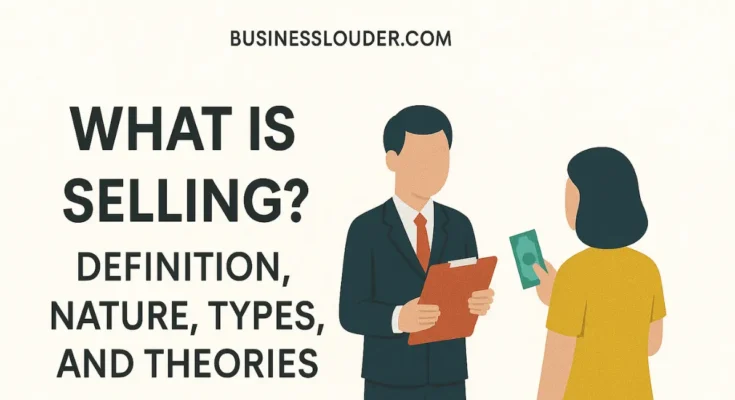If you are into business, chances are that you are selling something. Every business, no matter what kind of business, is involved in selling something or the other. It might be a product or a service, or it might be tangible or intangible. In fact, without making sales, no business would exist.
Here in this blog post, we have discussed what is Selling and its meaning, nature, types, and theories. Let’s first look at what selling means.
What is Selling?
Selling is a part of trade or transaction. It is the process of persuading potential customers or clients or an organization to buy some products, services, or ideas. The main motive behind this is to satisfy the needs and interests of buyers and for the seller to ultimately get paid.
Selling often refers to giving something, any service or product, in exchange for money. There must be a monetary transaction between the buyer and the seller for there to be a sale. Such interactions are not called “sales” if there is no exchange of money between them.
Putting it simply, selling is the act of persuading potential customers and involves any transaction in which money is exchanged for a service or product.
Definition of Selling in Marketing
There are a variety of selling definitions in marketing.
Hubspot defines ‘Selling’ as any transaction that is monetary in nature or in which money is exchanged in return for a good or service. During a sales negotiation, according to Hubspot, the seller attempts to convince or ‘sell’ the buyer about the benefits of their offer.
According to Ferdinand F. Mauser – The act of persuading or assisting a potential customer to either purchase products or services or to act favorably on a suggestion that has commercial value for the seller is known as “selling”.
Nature of Selling
The nature of the selling majorly depends upon the type of the product and place of sale. The different types of products may be consumer products, industrial goods, reseller products, technical and non-technical products, etc. Place of sales refers to the customers’ location or the place where delivery of the products is done.
The nature of selling may also depend upon the strategies of the firm in implementing the sales program and also the intelligence and influencing ability of its salesperson.
Thus, the nature of selling may be categorized as follows –
1. Selling is Commercially Significant
Selling has always had a commercial significance. By offering services, it works in terms of the exchange of money. Its end result is customer satisfaction, thereby earning a reasonable profit.
2. Selling is Correlated With the Management Concept
The process of selling is correlated with the concept of Management.
3. Selling is a professional activity
Selling is a professional activity because it requires sales experts and sales professionals to persuade potential customers, thereby making a profitable sale.
4. Selling is a Science and Art
Selling is a science because it consists of respecting business ethics, going through experiments and observations, and applying different selling theories.
At the same time, selling is an art because to make a sale, dramatization, attractive presentation, and tactful handling of compliments and objections are to be applied.
5. Inducting and Insisting the Prospects
Sellers involved in the sale make an effort to educate the potential customers about the goods. This makes it easier for customers to decide which products are the best to purchase and which ones are not.
When prospects have trouble deciding, sellers can also assist them. At their own risk, the salesperson guarantees the caliber of the specific good or service. Due to this, prospects can easily make on-the-spot purchases.
6. Selling as an Individual and Institutional Activity
Selling is an individual as well as an institutional activity. Depending upon the situation, an individual is involved in convincing another persona. Similarly, an institutional body is also involved in such an activity.
Types of Selling
Selling can be of different forms, but the 6 most important types of selling are:
1. Transactional Selling
The transactional approach focuses on making fast sales with no attempt to form long-term relationships with the customer. It’s a short-term strategy where the salesperson gathers leads, works on them, and focuses on selling as much as possible.
This approach is mostly followed in selling necessities where a simple transaction is all the customer needs.
2. Collaborative Selling
This type of selling forms the highest level of trust between the seller and the buyer and there develops more of a partnership between them.
3. Relationship/Consultative Selling
Consultative or Relationship Selling is the highest form of customer-oriented selling where the salesperson focuses on developing a deep relationship with the customers. Their goal is to get to know the customer’s needs and wants and do their best to give the customer what they want.
This type of selling requires a highly skilled sales force as the salesperson is seen as more of an advisor.
4. High-pressure Selling
Sales professionals are often told that to make a sale, they need to push hard to the buyers and not take “no” for an answer. However, most buyers don’t want to be pressured. This type of high-pressure sale usually either fails or leads to the buyer regretting their purchase.
5. Provocative Selling
In this type of selling, the salesperson points out a potential problem to the customer that he was not aware of. The customer then realizes that the problem needs to be addressed.
The salesperson then explains how and why their product can provide them with the solution to their problem, thus making a successful sale.
6. Solution Selling
In this type of sales process, the seller, rather than talking about the positive features and praising the product, explains how it can solve the customer’s problems. Here, the salesperson focuses more on the customer’s needs. When those needs are identified, the seller explains how their product can fill those needs.
Theories of Selling
The different theories of selling that we will be discussing now are as follows:
1. AIDAS Theory
According to this theory, a prospective buyer’s mind passes through 5 stages: attention, interest, desire, action, and satisfaction before the purchase. Based on this, the salesperson needs to take the potential buyer through all these stages effectively for the sale to close.
1. Attention
Grabbing attention is the first step. In this step, the salesperson needs to be dressed formally and behave in a friendly manner. The salesperson also needs to be alert and skilled in making conversations.
2. Interest
At this stage, the salesperson is required to draw the interest of the buyer after getting his/her attention. The use of portfolios, catalogs, or other visual aids will help in obtaining buyers’ interest in the product. The potential buyer sometimes gives out hints through questions which the salesperson can use to get his/her potential buyer interested.
3. Desire
The third step of the AIDAS theory of selling is piquing desire. After drawing the attention of a potential buyer and getting him/her interested in the product, the salesperson needs to make sure that the buyer also develops a desire for the product. To do this, the conversation should be focused on the product. Any obstacles or distractions should be avoided.
4. Action
Now, it is time to take action! At this stage, the potential buyer should be induced or encouraged to buy the product. If the salesperson has presented the product well, then the customer should be convinced about the value and merits of the product and will be ready to buy it. Sometimes, the salesperson asks directly whether or not the customer is interested in buying the product, but some salespeople don’t for fear of getting negative feedback. However, it is advisable to know the position of the potential buyer at this stage.
5. Satisfaction
This is the last stage of the AIDAS theory of selling. At the satisfaction stage, the salesperson should reassure the buyer of his/her decision to purchase. If the buyer does not yet feel convinced, then the salesperson can use samples or demonstrations to convince the buyer. At the final stage, the salesperson should thank the customer and clarify any queries that the customer may have after making the purchase.
2. The Right Situation Theory of Selling
The Right Situation Theory of Selling is also known as the ‘Right Set of Circumstances Theory’. As per this theory, the surrounding situations may cause potential buyers to respond in a predictable way.
Experienced salespeople who are skilled in handling internal and external situations can easily create the desired environment to get the buyer’s interest in purchasing the product. This theory, thus, stresses on the importance of manipulating the environment/situations in order to get the desired response from the potential customers.
3. The Buying Formula Theory of Selling
According to this theory, the salesperson needs to identify the problem of the customer and focus on providing a solution to that problem through his/her product or service. In this way, whenever the customer experiences that problem or need, he/she will automatically think of the given product, brand, or service.
In this selling theory, the purchase can take place only when the potential customer has been convinced that his/her problem can be solved by the given service or product. Due to the various competing products available in the market, the brand of the particular product’s superiority needs to be emphasized.
The Closing Lines
With this, we come to the end of our article about the basic concepts of Selling. We hope that you will find this article helpful and applicable to your own business.
Remember that every business organization is different, and every customer is different as well. So the approaches to selling the product or service will also differ each time. However, a skilled and experienced salesperson will make sure that the customer is convinced enough to make the purchase, thus creating profits for the business.
If you still have any questions related to this post, please let us know in the comment section below. We will definitely help you.




3 Comments on “What Is Selling? Definition, Nature, Types, and Theories”